The Legendary
Pultec "Passive" Equalizer
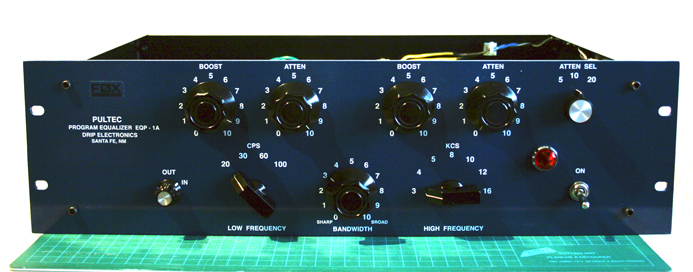
The DRIP Electronics EQP-1A kit Equalizer
We have a microphone client who lives in the high Arctic, way up on Baffin Island in Canada, who bought a Pultec Equalizer Kit from DRIP Electronics.
Zoom out on the map below. You will not believe how far north this is!
View Larger Map of Baffin Island
Our client needed a Pultec type EQ so he bought the kit and the parts and had everything delivered way up there. After surveying everything he realized it would take more time than he actually had because he is "the" recording studio up there (http://www.sikumusicstudio.com/) and is very busy. So he contacted us to ask if we could assemble it for him.
Sounded like a fun thing to do and we knew it would be an excellent opportunity to find out what this work-horse of the studio really did, so we took on the project.
But before we get to the Pultec performance let's talk a bit about "passive" versus "active" equalizers.
Passive vs Active Electronics
For those of you who work in audio but steer clear of the messy details of electronics it is important to start with where these terms come from. It then will become clearer what a "passive" EQ is.
In electronics the world divides into passive and active parts. Now passive parts don't just sit around like your sister in law, looking pretty. They are not that passive. It's just that they don't consume any electricity on their own. They don't need batteries or power outlets. They are just kind of... well you know... passive!
What they do depends totally on what kind of signal or electricity is fed into them. There are essentially three kinds of basic passive components.
Here is what they do:
- Resistor:
- resists the flow of any electrical current and turns it into heat
- makes sense, no?
- makes sense, no?
- resists the flow of any electrical current and turns it into heat
- Capacitor:
- stores up electrical charge
- But for our purposes this gives it the ability to block Direct Current (DC) electricity but let an audio signal pass through it.
- This means it affects low frequency signals differently than high frequency signals. (DC is the lowest freq. 0 Herz)
- Generally high frequenecies travel through it easier than low frequenecies
- AhHa! sounds like EQ already!
- AhHa! sounds like EQ already!
- Inductor (coil):
- resists any "change" in electrical current by turning it into magnetic fields
- Steady current flowing through an inductor is boring. Nothing happens.
- If the current changes, like with an Alternating current (AC), ie. an audio signal, slow changing currents (low frequencies) travel through it easier than fast changing currents (high frequences)
- For audio purposes a bit like the opposite of a capacitor
So if you were to consider these three things the "Lego" blocks of passive electronics, you can probably already imagine how you could create something that enhances one part of the audio spectrum while reducing another.
Active Electronics
Active electronics are components that use a source of electricity and in general they can amplify a signal.
Examples of active components are:
- Vacuum Tube (Valve in the U.K. A very accurate term)
- Uses a small amount of static electricity to control a larger amount of current flowing through a vacuum
- Uses a small amount of static electricity to control a larger amount of current flowing through a vacuum
- Transistor
- Uses semi-conductor metals like Silicon, Germanium or Gallium Arsenide
- Controls current flowing through the semi-conductor with a much smaller amount of current (bi-polar transistors)
- - OR -
- Controls current flowing through the semi-conductor with a small amount of voltage (Field effect transistor [FET] )
- OP-Amp
- A collection of transistors connected together on a common piece of semi-conductor that creates a theoretical ideal amplifier block
- Typically has response from DC (0 Herz) to very high frequencies, typically Mega-Herz
- Typically has very high amplification, 100,000 times or more
The Passive Equalizer
Anyone who has every played a traditional electric guitar or Bass guitar has adjusted a passive equalizer. The tone controls of these instruments are a great example of a passive High frequency control. In fact the Pultec High Frequency " Atten" control works very much like this.
Here is the circuit:
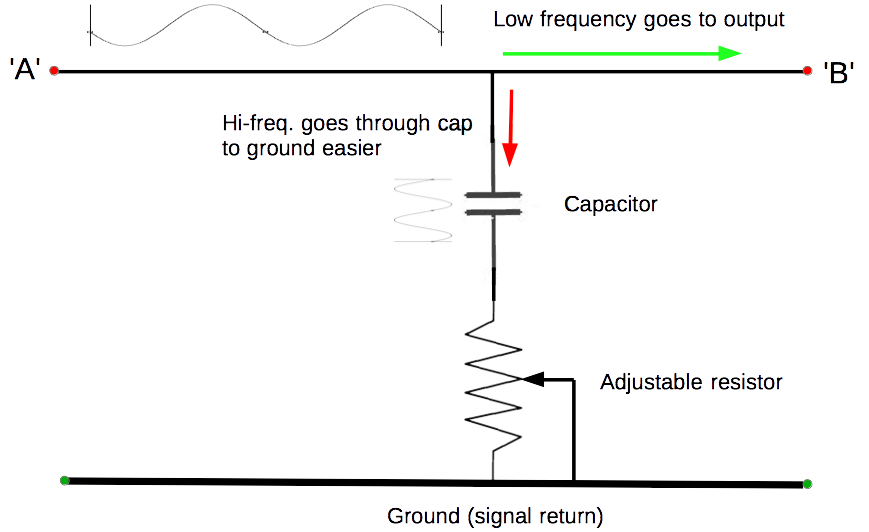
The signal travels from point 'A' to point 'B' and returns via the ground wire.
The resistor, remember resists any kind of electricity. The capacitor passes high frequencies easier than low frequencies. If the resistor is set to high resistance, almost no signal travels through the capacitor to ground. If the resistor is set to low resistance, signal travels into the capacitor and goes to ground instead of travelling along the wire to point 'B'.
The effect is that the treble sound is reduced while the bass sounds travel through almost un-changed. You can now understand passive EQ.
The Pultec uses a more complicated arrangement of passive components, resistors, capacitors and coils, but it works in exactly the same way. Various Capacitors and Inductors are put into the signal chain using selector switches and variable resistors allow those parts to have greater or lesser affect on the sound.
But hey, wait a minute! The Pultec has vacuum tubes in it. How can it be called passive?
The Pultec EQ is a PAD!
Yes, the Pultec has tubes and yes they do amplify the signal but they have a simple purpose. Consider the block diagram below:
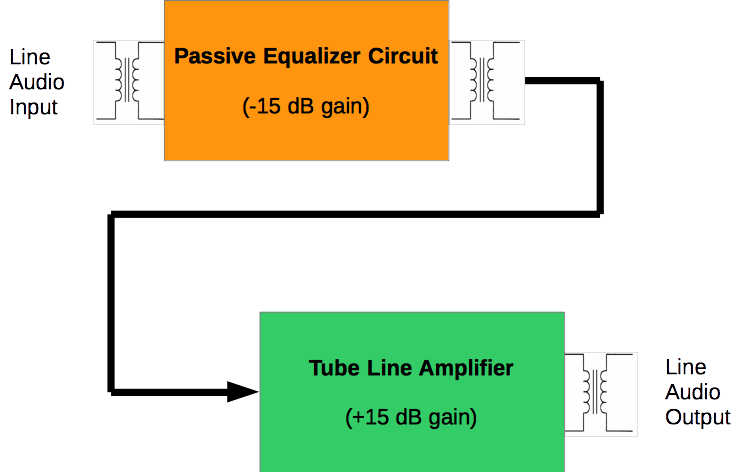
Pultec block diagram. The little things on input and output are transformers
Notice how the signal travels into a Passive equalizer circuit first. It is important to understand that when all the controls of the Pultec are set to '0' the EQ circuit has "gain" of -15 dB. That's right, the signal has to be reduced by default if we want to make a boost circuit because a Passive EQ cannot amplifiy a signal!
So the Pultec EQ circuit is just a 15 dB PAD by default!
When you want to boost the Bass or the Mid-Range, you are really by-passing that PAD with capacitors and inductors to let MORE signal get through. It's that simpl.
What about the tubes?
There are three tubes. One tube is a rectifier to turn the power company's AC electricity into DC electricty. No sound travels there.
The other two tubes are wired to create a very nice, low distortion, 2 stage Line Amplifier with exactly 15 dB of gain. That's right.
All the tubes do is make up the difference in the signal after it travels through the Passive EQ boards.
What goes in, comes out. Same level.
Well how do you like that...
But How Does it Sound?
So after the Pultec was assembled and running I put in our project studio to play with it. I was working on a country track and I wasn't happy with the Bass track. It was recorded with our LA610 (with mods of course) direct into the Apogee Ensemble and onto Logic. I took the track out of the DAW and looped it into the Pultec. I thought... wonder what the Bass Boost control does. I cranked up the control with the Frequency set to 60 "CPS" (cycles per second) :-)
OMG! That was the big studio sound that I was missing!!!
Take a listen to the raw Bass track
Pultec "Boosted" track
So now I needed to know what was going on. So I ran a sweep on the Pultec with the configuration the same as what I used on the Bass track and here is the response curve:
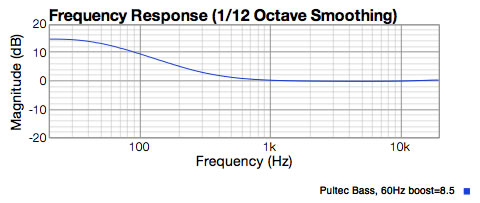
What I notice is the two things:
- The amount of Bass boost is much higher than I would normally use. (15 dB!)
- The boost is much wider than I would normally use
Notice how the "Bass" boost is actually starting to affect the signal way up in the lower mid-range around 700 Hz.
This is our big discovery. This Pultec is making very broad adjustments to the response that we just don't do with our modern DAW EQ controls.
We use an exacto knife and the Pultec is like a meat cleaver!
But the sound is amazing!
So the question now is:
"Can we make this sound with our modern EQ controls adjusted to create this response"
And the answer is... well you decide.
Setting our old Logic 8 EQ to this response:
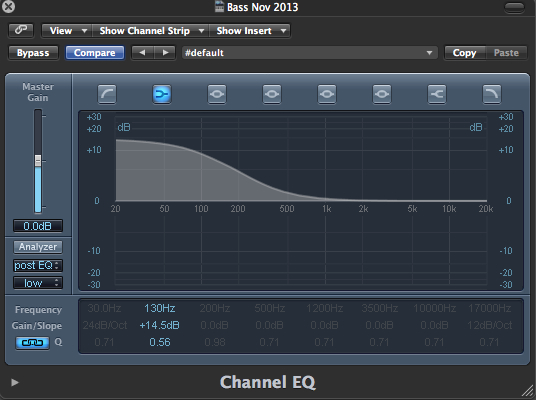
Using only LOGIC EQ,we got a Bass track that sounded like this:
It has been very educational for me. The sound of the Pultec has some magic to it. I can't argue that. Given a choice I would like to have the real thing.
But I am happy that once we did the analysis and understand the response of this beautiful old unit, we can simulate the sound, with some degree of accuracy in the project studio environment.
A bigger question occurred to me while doing this work. Are we using the wrong kind of user interface for our DAW based EQ? Perhaps the graph is prejudicing our senses. The Pultec does not give you a clue about how much you are boosting or reducing frequencies. It only tells you approxmately where in the audio band it will adjust. And even there it is somewhat missleading !
It all comes down to tuning with your ears and that is actually what it's all about. Making music.
Send any comments or questions to:
brian.fox at foxaudioresearch dot ca
